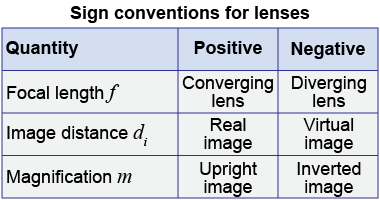|

| When using the thin lens formula in equation (21.3), a real image has a positive value of the image distance, i.e., di > 0. As you will see in the solved problem below, a virtual image is represented by a value of di < 0. A negative image distance means that the image is located on the same side of the lens as the object—the left-hand side of the illustrations above). As you learned on page 614, a virtual image cannot be projected onto a piece of paper. |

|
In the previous chapter, we learned that the magnification of an image is the ratio of the image height to the object height. An alternate equation for the magnification is the negative of the ratio of the image distance to the object distance. 
|
| (21.4) | | | m | = | magnification | | di | = | image distance (m) | | do | = | object distance (m) |
| Magnification
alternate definition |
|
Why is there a minus sign in equation (21.4)? Look at the ray diagram for a convex lens on page 615. The image is inverted, which corresponds to the minus sign in equation (21.4). A negative magnification means that the image is inverted, whereas a positive magnification is an upright image. 
 |
How can you use the thin lens formula for a concave or diverging lens? A diverging lens has a negative curvature, so its focal length is negative. Converging lenses have positive curvature and positive focal lengths. The thin lens formula will predict the image location for both converging and diverging lenses if you make sure to use the appropriate sign for the focal length. 
|
A magnifying glass with a focal length of 20 cm is held 15 cm above the page of a book.
(a) How far from the lens is the image located? (b) Is the image real or virtual?
(c) What is the magnification of this image? (d) Is the image upright or inverted? | Asked: | (a) image distance di; (b) whether image is real (di > 0) or virtual (di < 0); (c) magnification m of the image;
(d) whether the image is upright (m > 0) or inverted (m < 0) | | Given: | object distance do = 15 cm, focal length f = 20 cm | | Relationships: | | | Solution: | (a) Solve for 1/di in the thin lens formula and calculate: Invert both sides of the equation to get di = 1/(−0.0167 cm−1) = −60 cm. (b) The image distance is negative, so this is a virtual image and it is therefore located on the same side as the object.
(c) Use the magnification equation: | |
(d) The magnification is positive, so the image is upright. | | Answer: | (a) di = −60 cm. (b) It is a virtual image. (c) Magnification m = +4.
(d) It is an upright image. | 
|
When a 20-cm-tall object is placed 40 cm from a lens, an image forms 60 cm from the lens on the other side. What is the magnification? - −3/2
- −2/3
- 2/3
- 1/3
 |
The correct answer is a. The image is enlarged and inverted.
Asked: magnification m of this system
Given: object distance do = 40 cm; image distance di = 60 cm
Relationships: m = −di ⁄ do
Solve: 
|
Consider the same 20-cm-tall object placed 40 cm from a lens, with an image forming 60 cm from the lens on the other side. What is the height of the image? - −60 cm
- −30 cm
- −6.66 cm
- 13.33 cm
 |
The correct answer is b.
Asked: image height hi
Given: object height ho = 20 cm; magnification m = −3/2 (previous answer)
Relationships: m = hi ⁄ ho
Solve: Rearrange and solve equation for hi: 
|

